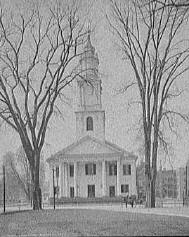|
First Century of the History of
Springfield:
Photo: First Church, Springfield, 1908, Detroit Publishing Co., Library of Congress |
|
|
|
|
| The information about Blisses in this section has been
extracted from the First Century of the History of Springfield: The
Official Records from 1636 to 1736 with an Historical Review and Biographical
Mention of the Founders by Henry S. Burt, published by Henry M.
Burt, 1898-1899.
|
|
Why was so much attention paid to seating people in the meeting house? Here is what Henry Burt said: Seating the People in the Meeting-House "The selectmen and the deacons or a committee appointed by the selectmen, determined the order in which the seats in the meeting-houses in New England, in the early settlement, should be occupied, Ability and general regard, as well as wealth, had much to do with the order of selection. The women, as a rule, do not appear to have been assigned to particular seats, but occupied, in another part of the house, such as suited their own preferences. The lists still preserved, which give the order of seating the men and boys in Springfield, do not indicate any great regard for those having the largest possessions. At Northampton, "age and estate" determined the order, and to some extent that might have prevailed here." (p. 126, vol. 1) What did these town officials do? Sealer of Leather The leather sealer was the town officer who had authority to see that all sales of leather were made honestly as to quality and quantity. The sealer of leather was authorized to put his "seal" or stamp of approval on items he inspected, tested and certified. Fence Viewer A fence-viewer was responsible for inspecting new fences and settling disputes over trespassing by escaped livestock. Surveyor of Highways "..By 1638 the General Court, the Colony's legislative body, ordered that roads between Hartford and Windsor be laid out, and in 1640, that roads between the early towns be maintained. Soon thereafter, the construction, care and maintenance of highways was formally placed on the towns by the General Court, primarily to ensure the care of the route between the Connecticut Colony in Windsor and the Massachusetts Bay Colony in Cambridge, Massachusetts. This route was used by Connecticut Colony founder Reverend Thomas Hooker and his assistant Samuel Stone in 1636. In 1643, the Court ordered each Municipality to appoint two officials, known as surveyors, who were given the power to "call out every Teeme and person fitt for labour, in their course, one day every yeare, to mend said highwayes wherein they are to have a spetiall to those Common wayes which are betwixt Towne and Towne." This compulsory labor statute was enlarged in the 1650 Code of Laws, which authorized financial Penalties on those men who failed to meet their annual road work obligation of two days work a year: "if any refuse or neglect to attend the service in any manner aforesaid He shall forefeit for every dayes neglect of a mans worke two shillings sixpence, and of a Teame, sixe shillings . . ." This act formalized a custom that dated at least from medieval England. It would continue to remain in effect until the nineteenth century, providing the main source of workers for road and bridge construction.
Bridges were also under the jurisdiction of the General
Court. In 1651, the Court resolved that a bridge should be built over
the Connecticut River at Hartford (although such a bridge was not to be
built until 1810). Throughout the seventeenth century, the Court ordered
that bridges be built in a variety of locations."
Tithing Men A tithing man was a parish officer
elected annually to preserve good order in the church during divine
service, to make complaint of any disorderly conduct, and to enforce the
observance of the Sabbath.
Town Clerk "When the early colonists came to America they set up forms of local government to which they had been accustomed, and the office of clerk was one of the first to be established. When the colonists first settled in Plymouth, Massachusetts, they quickly appointed a person to act as recorder. That person kept all the vital records for birth, marriages and deaths for the church, as well as various other records of appointments, deeds, meetings, and the election of officers at the annual town meeting. Indeed, in Massachusetts, the town clerk was one of the earliest offices established in colonial towns. The settlers were well aware of the importance of keeping accurate written records of their agreements and actions including grants of land, regulations governing animals, the collection of taxes and the expenditure of town funds. The person given the responsibility for recording these
orders was also often given others duties, such as sweeping the
meeting-house and selling the seats, ringing the bell, and paying the
bounty for jays and blackbirds whose heads were presented to him by the
citizens. By the middle of the 17th century, the title town clerk
appears in town records and this title has continued to the present." |
